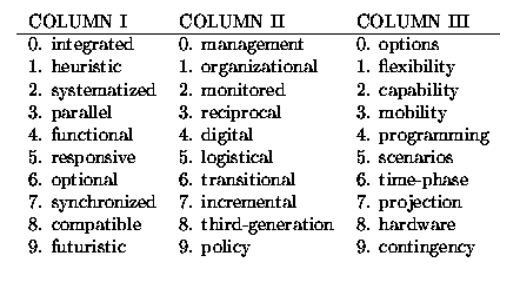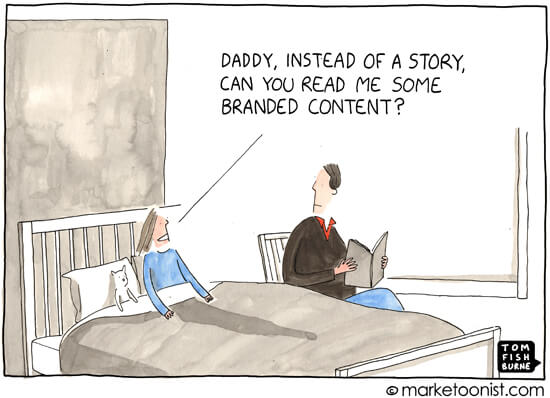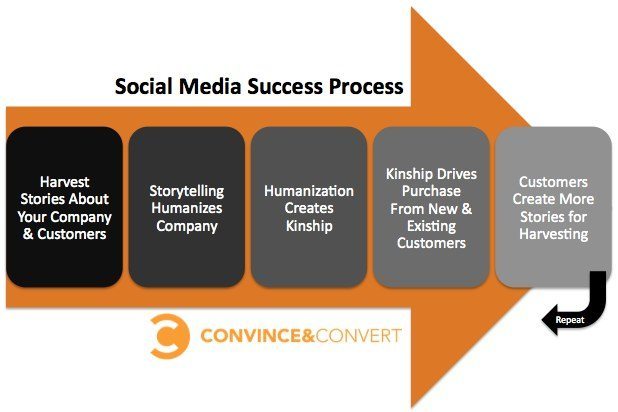A couple of years ago, I happened upon a fun game that has become an internal activity of sorts.
It’s a buzzword game, and anyone can play it—you don’t have to work at Spin Sucks to play along.
(Though we should totally create a way to play it in the Spin Sucks community and add adult beverages into the mix.)
Just choose a set of numbers.
Let’s say… 2, 9, and 4.
Then look at the corresponding chart: systemized policy programming.
 Voila! I now have the next sentence I’ll use in a presentation.
Voila! I now have the next sentence I’ll use in a presentation.
Systemized policy programming.
You can actually picture someone saying that, can’t you?
It doesn’t mean anything and yet…
Buzzwords Do Not Work in Brand Storytelling
I’ll never forget this experience. I was standing in the security line at the Atlanta airport and couldn’t help but eavesdrop in on the conversation of the guy ahead of me.
He was on the phone with his assistant and it was clear they were preparing for a workshop the next day.
He was very proud of his MBA and all of the buzzwords he learned in school.
As they discussed what was needed for the workshop, he said:
You’ll have to order lunch. I don’t have visibility into the menu.
Visibility?
That’s right. He didn’t have visibility into the menu.
He went on to tell her that the logistics of said lunch needed to be monitored by her so he could focus on providing organizational programming for their clients.
Major. Eye. Roll.
This is a great example of why buzzwords do not work.
Just like a child does not want to hear branded content (a la the image above), neither does your customer.
We all want stories.
Of course, that’s one of the most challenging parts of our job—telling a story about a brand.
But it doesn’t have to be that hard. Au contraire! It could be pretty fun, if you want it to be.
The Brand Storytelling Process
Jay Baer has the best example of brand storytelling than any I’ve seen before or since.
The very best way to create your organization’s story is to have your customers and employees do the work for you.
I tell this story when I speak—and it’s one of my favorites.
A few years ago, I was in Omaha speaking to a group of business owners.
I was doing my three-hour workshop and we were discussing this very topic—how to tell your story.
An attendee started to debate me when I showed this image.
He said:
I’ve been with you this whole time, but I have to say, I don’t agree about this part.
As it turns out, he runs a commodity business. No one cares about their story. They just care if the product will cost a penny less every year.
He told me he just could not focus on brand storytelling as part of his marketing efforts.
But I had the advantage of 14 other business owners in the room who know this man’s business.
One of them mentioned the man only hires people without sight.
A key differentiator, perhaps?
Then I learned that his employees are not only without sight, but they do things 99% of the population does not.
They climb mountains and are gospel singers and give back to their communities.
After a good amount of cajoling, we finally got him to agree to tell their stories on video, and post them on the website.
It wasn’t overnight success, but fast forward to today.
His business is no longer commoditized and he’s beat out his competitors the last two years running.
All because of brand storytelling in a compelling way that isn’t full of jargon or buzzwords.
Five Parts to Brand Storytelling
I’m always amused that we all complain about how bad some of the messaging is from organizations, yet many of us get behind our computer screens and pump out crap no one wants to read.
We know it’s crap. We know no one wants to read it. And yet.
I get it. I do. You have bosses or clients who insist it be full of corporate speak and jargon. But it’s our jobs to change the thinking around this.
There are five essential parts to brand storytelling.
They include: passion, a protagonist, an antagonist, a revelation, and the transformation.
Passion
What is it your audience really cares about?
Mailchimp tells their customers stories in interesting ways.
They don’t have their customers talk about how they use MailChimp. They have them talk about their restaurant or their fashion design company or their business cartoons.
These aren’t customer quotes or testimonials; these are customer stories.
The passion lies in how your product is created, your office culture, the one thing your organization truly cares about that makes you unique and valuable to the world around you.
The Protagonist
The protagonist is you, your company, your product, or your service.
This is typically where stories begin and end, but in the brand storytelling process, this is just the beginning.
To figure out who your protagonist is—the leader of the organization, a social media rockstar within your ranks, a spokesperson, a cartoon superhero of your logo—ask a handful of people in various roles to share five adjectives they’d use to describe the company and two aspects of the organization that are unique or valuable.
Ask people inside your organization and your customers to contribute. Look for themes or strong responses and combine them into a clearly defined description of your protagonist’s attributes.
Remember when U.K.-based Bodyform—the maker of women’s products—went on the defensive when someone posted on their Facebook wall that a woman’s period is nothing like a tampon ad?
They responded with a very funny video that made the CEO the protagonist in their story.
It was interesting, it had a great sense of humor, and it brought more awareness to their brand.
Heck, I’m fairly certain we shared the video in Gin and Topics a few years ago.
The Antagonist
The antagonist is the villain and is often the most overlooked part of an organization’s story.
What is the enemy of your success?
Think about it as an issue or challenge you solve.
What keeps your customers awake at night?
Is it a cultural issue?
Is it an industry concern?
Perhaps you work in print distribution and the products you make are becoming extinct because everything is going online and you no longer have something to distribute?
Maybe it’s a real problem like the hassle of setting up payroll, or you have email overload.
Chicago-based 37 Signals, the creators of Basecamp, discovered there was a problem for small-and medium-sized businesses in using customer relationship and project management software because what existed was far too expensive and was built only for very large companies.
They also knew the web should empower, not frustrate.
Their antagonist, then, became the big enterprise software solutions for both customer relationship and project management.
The Revelation
Part of what makes fiction so compelling are twists or turns you weren’t expecting.
We enjoy the surprise and delight, even if the revelation is sad, because we like to feel like we’re being let in on a secret.
Likewise, your organization’s story should share something unexpected with customers and prospects.
There is an interesting company called FoldIt that creates games as a way to solve real issues, such as new insights for the design of antiretroviral drugs for AIDS patients.
The company is billed as online gaming, but the big revelation is the games serve the purpose of finding a needle in a haystack—something scientists may miss by not being able to see the forest for the trees.
The Transformation
The final part to your story is the transformation, or the thing (or things) that is different about the way you do business.
Think about how your company has evolved.
Think about the problem you solve and how it connects with both emotional and practical needs.
What is your value proposition? What can customers get only from you?
It might be intellectual property or a new way of doing things or a super duper cool new widget.
People want to know how you arrived there.
The argument many business leaders make at this point is:
Why would I want to give away our secret sauce? Then our competitors would do what we do.
Here’s the thing: your competitors may know the exact recipe to your secret sauce, but no one does it as well as you do.
It’s your secret sauce.
It was created with your people, your thinking, your culture, your passion, and your vision.
Tell the story from your point-of-view and no one can copy it.
Pulling It All Together
You also need to start with an idea, theme, or concept.
Going out and telling the company’s history isn’t going to fly. Choose one interesting tidbit and start there.
If you’re my new friend in Omaha, you have your employees talk about their hobbies, and loop their jobs into what they do outside of work.
My name is Gini. I’m a cyclist and I race every summer. I’m ultra-competitive, which doesn’t translate well while leading colleagues. As the founder of my organization, I’ve found getting that competitiveness out on the bike makes me a better leader when I get to work.
See how that begins to work much better than:
We were founded in 2005 with a computer, a spreadsheet, and a kitchen table.
Choose your passion, protagonist, antagonist, revelation, and transformation.
If you do those five things in all of your brand storytelling, every person in the world is going to want to know more.
photo credit: Tom Fishburne at Marketoonist

